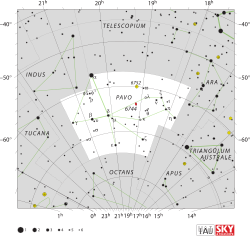| Observation data Epoch J2000 Equinox J2000 | |
|---|---|
| Constellation | Pavo |
| Right ascension | 21h 26m 26.60484s[1] |
| Declination | −65° 21′ 58.3145″[1] |
| Apparent magnitude (V) | 4.22[2] |
| Characteristics | |
| Spectral type | F9 V Fe-1.4 CH-0.7[3] |
| U−B color index | −0.13[4] |
| B−V color index | +0.48[4] |
| Variable type | Suspected |
| Astrometry | |
| Radial velocity (Rv) | −29.9[5] km/s |
| Proper motion (μ) | RA: +80.56[1] mas/yr Dec.: +800.60[1] mas/yr |
| Parallax (π) | 107.97 ± 0.19 mas[1] |
| Distance | 30.21 ± 0.05 ly (9.26 ± 0.02 pc) |
| Absolute magnitude (MV) | 4.40[5] |
| Details | |
| Mass | 1.21±0.12[6] M☉ |
| Radius | 1.15±0.04[6] R☉ |
| Luminosity | 1.52±0.05[6] L☉ |
| Surface gravity (log g) | 4.3[2] cgs |
| Temperature | 6,112[2] K |
| Metallicity [Fe/H] | –0.80[2] dex |
| Rotational velocity (v sin i) | 1.0±0.6[6] km/s |
| Age | 1.0[5] or 7.25[7] Gyr |
| Other designations | |
| Database references | |
| SIMBAD | data |
Gamma Pavonis, Latinized from γ Pavonis, is a star in the southern circumpolar constellation of Pavo. With an apparent visual magnitude of 4.22,[2] it is a fourth-magnitude star and thereby visible to the naked eye. From parallax observations with the Hipparcos satellite, the distance to this star has been estimated at 30.21 light-years (9.26 parsecs).[1] It is drifting closer to the Sun with a radial velocity of −30 km/s.[5]
Compared to the Sun, this star has a 21% greater mass and a 15% larger radius. It is a brighter star with 152% of the Sun's luminosity,[6] which is it radiating from the outer envelope at an effective temperature of 6,112 K.[2] The stellar classification of F9 V[3] puts it in the class of F-type main sequence stars that generate energy through the nuclear fusion of hydrogen at the core. It is a metal-poor star, which means it has a low abundance of elements heavier than helium. Age estimates range from a low of a billion[5] years up to 7.25 billion years.[7] Gamma Pavonis is orbiting through the Milky Way at an unusually high peculiar velocity relative to nearby stars.[citation needed]
This star has rank 14 on TPF-C's top 100 target stars to search for a rocky planet in the Habitable Zone, approximately 1.2 AU, or a little beyond an Earth-like orbit.
- ^ a b c d e f Cite error: The named reference
aaa474_2_653was invoked but never defined (see the help page). - ^ a b c d e f Cite error: The named reference
aaa341_241was invoked but never defined (see the help page). - ^ a b Cite error: The named reference
aj132_1_161was invoked but never defined (see the help page). - ^ a b Cite error: The named reference
clpl4_99was invoked but never defined (see the help page). - ^ a b c d e Cite error: The named reference
aaa501_3_941was invoked but never defined (see the help page). - ^ a b c d e Cite error: The named reference
mnras405_3_1907was invoked but never defined (see the help page). - ^ a b Cite error: The named reference
mosser2008was invoked but never defined (see the help page).
